
ASER Centre
Evidence for action- Home
- About Us
- ASER Survey
- Research & Assessment
- Capacity Building
- Publications & Reports
- ASER Reports
- ASER Data Over Time
- ASER 2022: Chhattisgarh
- ASER 2022 'Young Children'
- ASER 2022
- ASER 2021: West Bengal
- ASER 2021: Chhattisgarh
- ASER 2021
- ASER 2020 Wave 1
- ASER 2020 Digital Recheck
- ASER 2020: Karnataka
- ASER 2019
- ASER 2018 'Young Children'
- ASER 2018
- ASER 2017
- ASER 2016
- ASER 2015: Maharashtra
- ASER 2015 : Punjab
- ASER 2014
- ASER 2013
- ASER 2012
- ASER 2011
- ASER 2010
- ASER 2009
- ASER 2008
- ASER 2007
- ASER 2006
- ASER 2005
- Odisha Tribal Study 2022
- ASER Health Report
- Study on Access, Transition and Learning in Secondary Education
- India Early Childhood Education Impact Study
- Urban Ward Surveys
- Bihar Elementary School Study
- Inside Primary Schools
- PAHELI
- External Publications
- ASER Reports
- Data Query
- Impact
Did Technology Enable Inclusive Learning in Rural India in a Year of Lockdown?
This report, a complement to the ASER 2020 report, looks at the ASER 2020 data from an equity lens. So while some sections and tables have been repeated from the ASER 2020 report (for instance sections on the ASER process, sampling and enrolment patterns) for the sake of completeness, the report adds new analysis focusing on the digital divide based on unequal access to technology.
Click to read

Citizen-led Assessments: A Model for Evidence-based Advocacy and Action to Improve Learning
Designed as household-based assessments, citizen-led assessments (CLAs) are implemented by local organizations who assess children in their homes, thus reaching the most marginalized children, families, and communities, often in remote areas. CLAs add an essential piece of information for truly monitoring progress and help realistically represent the learning levels of all children – at national, regional, and global levels.
By using simple tools and easy-to-understand reports, CLAs engage parents and community members in discussions about learning and help foster understanding of the importance of ensuring quality education through civil action. In this publication, members from organizations conducting CLAs in India, Pakistan, Nepal and Bangladesh provide an overview of the CLA model and illustrate a range of ways in which the model has been implemented in the four South Asian countries to monitor and improve learning.
In all four countries, the initiative is known as the Annual Status of Education Report, or ASER – a word that means ‘impact’ in three of these four countries. By design, ASER assesses foundational reading and numeracy skills.
To read more click
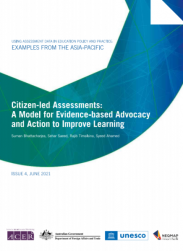
Fostering equitable access to quality preschool education in India: challenges and opportunities
ASER 2019 ‘Early Years’ findings have been widely cited in the paper titled ‘Fostering equitable access to quality preschool education in India: challenges and opportunities.’ The paper focuses on the provision of center-based preschool education for children ranging in age from 3 to 6 years in India. It estimates access rates to various services and highlights issues related to equitable access to preschool services and the quality of preschool education. It argues that increased budget allocations to preschool education, prioritizing professional preparation of the early childhood workforce and harnessing technology to monitor government programs have considerable potential to enhance the early childhood system.
To read more click

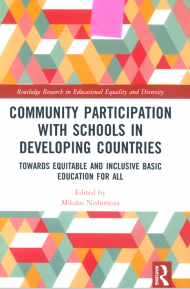
Can communities mobilize for schooling and learning? Bottom-up perspectives from Pratham in India
Dr. Rukmini Banerji, CEO, Pratham Education Foundation, writes in ‘Community Participation with Schools in Developing Countries’ published by Routledge Research in Educational Equality and Diversity in 2020.
The chapter, ‘Can communities mobilize for schooling and learning? Bottom-up perspectives from Pratham in India,’ outlines three phases of the evolution of Pratham’s efforts on the ground. The first section describes the early phase, which largely focussed on achieving access. The next section features the following decade of Pratham’s work, which was aimed at expanding participation, engaging communities, and exploring the links between awareness, assessment, and action. The ASER survey is referenced prominently in this section. The third section analyses how to ensure effective learning and durable impact.
Read more here.
Harnessing the Power of Data for Gender Equality
ASER 2017 data has been cited in a report titled ‘Harnessing the Power of Data for Gender Equality – Introducing the 2019 EM2030 SDG Gender Index’. This report is a joint effort of leading regional and global organizations from civil society and the development and private sectors.
Page 26 of the report references ASER - “citizen‐led data collections in India and Pakistan show that rural girls are losing out on basic skills: according to the Annual Status of Education Report’s (ASER) assessment of basic math skills of 14–16 year‐olds in India, 44 percent of girls can do division compared to 50 percent of boys.”
Click here to read more.

Understanding What Works in Oral Reading Assessments
The UNESCO Institute for Statistics (UIS) led a collaborative project to formulate recommendations to guide practitioners when selecting, conducting and using oral reading assessments. The aim is to highlight basic principles that should be applied in the different stages of oral reading assessments—from planning and design to implementation and use of the resulting data. The report uses ASER data and the survey's methodology and processes in Chapters 3 and 4. Click here to access the report.

Learning evidence in reading and arithmetic in children age 5 to 16 in India
Dr. Suman Bhattacharjea, Director of Research at ASER Centre writes in ‘SDG 4 Data Digest: Data to nurture Learning’ published by UNESCO Institute for Statistics (UIS) in 2018. The chapter, ‘Learning evidence in reading and arithmetic in children age 5 to 16 in India’, highlights three important trends visible through ASER data from 2006 to 2016 and further discusses challenges that emerge from these trends.
Click here to read more.

Betrayal or Benefit
Dr. Rukmini Banerji, CEO, Pratham Education Foundation, writes a paper, ‘Betrayal or Benefit’ in the June 2018 edition of India Seminar. The paper focuses on children who have reached class 8, the end of the elementary stage of schooling and also the point at which compulsory schooling ends. Based on available data on this age group and on a set of recent empirical studies, the paper aims to shine a spotlight on what these children have achieved in terms of schooling and learning and on their likely future prospects beyond this stage.
Click here to read the paper.
When Schooling Doesn’t Mean Learning
Dr. Rukmini Banerji, CEO, Pratham Education Foundation, writes in the Stanford Social Innovation Review. The paper explores how The Annual Status of Education Report (ASER), a simple, citizen-led assessment is helping citizens gauge children’s learning levels—and challenging a deep-seated belief that going to school means getting an education.
Click here to read the paper.
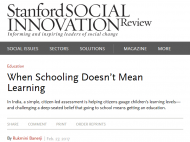
Teaching at the Right Level: The Government’s New Education Policy Must Include Solutions to Teach Students Basics
Gautam Patel, a senior policy manager at the Abdul Latif Jameel Poverty Action Lab (J-PAL), in his article in The Caravan Magazine, highlights the need to 'teach at the right level' - using a case study of a scale-up programme jointly conducted by Pratham and JPAL in Anantapur district in Andhra Pradesh. The programme, which lasted approximately four months (January - April, 2016), showed promising results. Read the article here.

The Case for Global Standardized Testing
Justin Sandefur, a senior fellow at the Center for Global Development, in his blog post compares the methodology and results of standardised tests such as PISA and PIRLS against grassroots, citizen-led assessment initiatives like ASER and Uwezo to make a case for why we need a global standardised testing regime.
How can education systems become equitable by 2030?
This think piece, written by Pauline Rose and Benjamin Alcott, is part of a series commissioned by the UK’s Department for International Development (DFID). This paper identifies that learning inequalities start early in the primary school cycle, or even before children start school. It further shows that achieving a target central to the SDGs, namely ensuring all children, regardless of circumstance, are learning the basics by 2030, will require a step-change in progress over the next 15 years that will not be achieved by ‘business as usual’.

Millions Learning: Scaling up Quality Education in Developing Countries
The Millions Learning report, released by Brookings Institution, examines where and how quality education has scaled in low- and middle-income countries around the world, with the ultimate goal of helping more children and youth gain access to high-quality learning experiences that lead to lasting improvements in their lives. The story emerges from wide-ranging research on scaling and learning, including 14 in-depth case studies from around the globe. ASER data has been cited in the report and its executive summary. Pratham's Read India program in particular serves as a case study in the report.
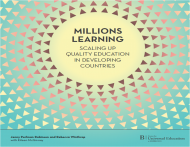
English in Education: Bihar State Profile
This profile of Bihar aims to investigate educational systems in the state and the place of English within them. It presents a snapshot based on the most up-to-date research and statistics available at the time of writing this report. ASER data has been heavily cited in the report to evaluate the educational environment in primary and secondary schools in Bihar.

Student Learning in South Asia - Challenges, Opportunities & Policy Priorities
Over the past decade, South Asia has made impressive strides in expanding access and improving enrollment in primary and lower secondary education. Despite these significant gains, this report documents that learning outcomes and the average level of skill acquisition in the region are low in both absolute and relative terms. ASER data has been extensively used in this study to understand what kinds of interventions hold promise for improving learning outcomes in South Asia and whether incentive structures in the system are aligned with countries’ learning goals. The study attempts to answer three questions: How well do education systems in South Asia perform? What determines student learning outcomes? What policy options are effective in improving learning outcomes, especially given increasing demand and competition for public resources?

How Can Education Systems Become Equitable by 2030? DFID think pieces – Learning and equity
In this paper released in August 2015, authors, Pauline Rose, Professor of International Education and Benjamin Alcott, Research Fellow, University of Cambridge, cite ASER data to explain how learning inequalities start early in the primary school cycle, or even before children start school. Read the full paper here. For the blog post on the paper, click here.
Learning Achievement at Elementary Level in Rural West Bengal
Rabindranath Mukhopadhyay and Dibakar Chatterjee, Department of Economics, University of Calcutta, use ASER data to understand the current state of primary education in West Bengal with a focus on district-wise achievement levels. The paper also seeks to establish the correlation between gender, household income, mother's education, school type, tuition on learning outcomes. You can access it here.
How Much Does India Spend on Elementary Education?
Ambrish Dongre, Fellow of the Centre for Policy Research and Avani Kapur of Accountability Initiative reveal estimates of annual public expenditure per student in government schools, and annual private expenditure per student for those enrolled in private schools, for 16 selected states in India. Read the paper here.
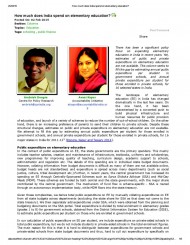
Do “Child Friendly” Practices affect Learning? Evidence from Rural India
Sushmita Nalini Das's paper examines the effects of "child-friendly” practices on learning in rural India. These are a set of pedagogical practices intended to improve education outcomes by increasing children’s inclusion in their learning environment. This paper offers the first quantitative evidence of their impact. Click here to read the paper.
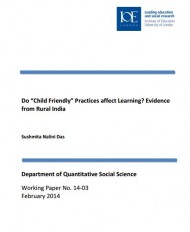
11th EFA GMR : Teaching and Learning : Achieving Quality for All
The 11th Education For All Global Monitoring Report provides an update on the progress made by countries towards achieving those global education goals that were agreed upon in 2000. It also makes a powerful case for placing education at the heart of global development agenda after 2015. The Annual Status of Education Report findings have been used extensively in the 11th EFA Global Monitoring Report. Access the sections with ASER findings here. To read the full report, click here. Aaron Benavot's background paper for EFA Global Monitoring Report 2015: achievements and challenges can be found here.

Cross-Country Review of Public Primary Education in Rural Context
Columbia Global Centers and Model Districts Education Projects recently published a paper comparing public primary education systems in Rural Brazil, China, Indonesia and Mexico to provide suggestions for policy and practice reforms in India. Read the full report here.

English Impact Story: Investigating English Language Learning Outcomes at the Primary School Level in Rural India
This joint study by ASER Centre and British Council presents an in-depth analysis of English teaching and skills of primary aged children in India. Read the full report here.

World Bank Symposium: Assessment for Global Learning
The international symposium held in November 2013, brought together technical experts and policy researchers to provide a platform to review and discuss the existing menu of tools and approaches for monitoring and supporting student learning, and to explore how best they can be used or improved to meet the needs of the post-2015 development agenda. The ASER tool and approach finds a significant mention in this report on the symposium.
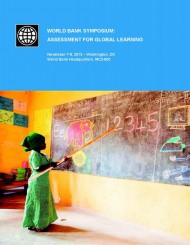
Chudgar, Amita. "Variation in Private School Performance: The Importance of Village Context". Economic & Political Weekly, Vol. XLVII, No. 11, March 17, 2012
Using ASER 2009 data, this paper investigates the linkage between private school performance and the contexts within which these schools operate. The results from this study indicate that the "positive private effect" or the private-public performance gap does vary based on the village context. Read the full paper

Investigating the Implications of School Provision and Supplemental Help: India Infrastructure Report - 2012
India Infrastructure Report 2012 discusses challenges in the education sector – elementary, secondary, higher and vocational – and explores strategies for constructive change and opportunities for the private sector. Dr Rukmini Banerji and Wilima Wadhwa co-authored Chapter 5 of this report, titled 'Investigating the Implications of School Provision and Supplemental Help'. Read the chapter here.

© 2025 ASER CENTRE | B 4/58 Safdarjung Enclave, New Delhi 110 029 | 91 11 4602 3612 / 2671 6084